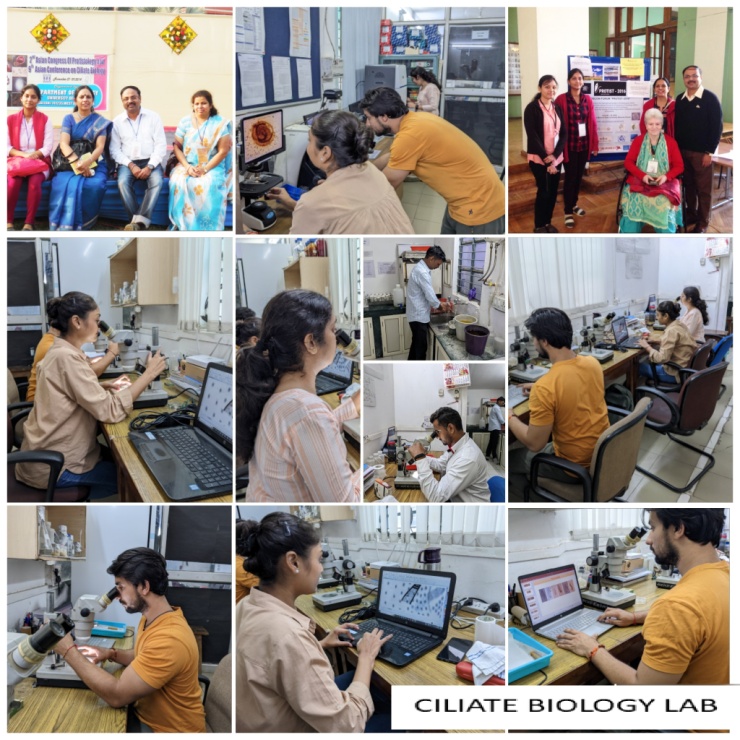Research on ciliated protists in the Department of Zoology, University of Delhi was initiated by Prof BL Bhatia in 1932 who published a memoir. The legacy continued with Prof BR Seshachar when he joined the University’s Zoology Department. After his retirement in 1970, ciliates continued to be in the center stage of investigations by his students Prof CMS Dass, Prof DM Saxena and Prof GR Sapra. Since the mid-eighties, Prof GR Sapra and his group were engaged in exploring ciliates in cellular ageing, influence of metals on development, biodiversity and systematics. Prof Renu Gupta, Prof Seema Makhija and Prof Ravi Toteja established the Ciliate Biology Research Laboratory in Acharya Narendra Dev College (ANDC); unfortunately we lost Prof Gupta to a medical exigency. Dr Komal Kamra shifted base from her research laboratory in SGTB Khalsa College and has joined the lab at ANDC. The on-going research is mainly on the ecotoxicology, barcoding, biodiversity and systematics of ciliates from soil and freshwater ecosystems in and around Delhi.
Our earlier collaboration with International Research Coordination Network for Biodiversity of Ciliates (RCN-BC) funded by National Science Foundation, USA paid rich dividends. Recently we were officially affiliated to Indian Network on Soil Contamination (INSCR). The group has an on-going association with several renowned National and International scientists of this field.

Some Research Interests of the Ciliate Biology Group @ Delhi:
Cellular and molecular response of ciliates to various stress (Heavy metals, Temperature, pesticides and UV radiations)
Heavy metal pollution of water is of major concern these days especially in developing countries like India. Anthropogenic sources, mainly mining and industrial activities, have contributed to substantial increase in heavy metal content in air and in many terrestrial and aquatic ecosystems. The research interest of our group is to examine how spirotrich ciliates respond to metal stress and to see the expression of heat shock proteins, metallothioneins and glutathione peroxidase gene under heavy metal stress. Moreover, the transcriptional activity of these genes are studied following heavy metals stress.
Biodiversity of spirotrich ciliates
We are also focusing on taxonomic description of freshwater ciliates by using morphological and molecular markers. We isolate and identify the ciliates from freshwater source in and around Delhi by studying its morphology, morphogenetic stages and using molecular markers like 18S rRNA gene, ITS1 and 2, histone gene etc.
Barcoding Ciliates
DNA based taxonomic identification has been an important tool for multicellular organisms; for example, fish, insects, birds, mammals, plants and fungi. Ciliates have thus far largely been ignored in large collaborative barcoding initiatives and projects, although they are more diverse than multicellular eukaryotes distributed in nearly all habitats and are essential component for ecosystem processes and stability. Protist Working Group (ProWG), initiated by the Consortium for the Barcode of Life (CBOL, http://www.barcodeoflife.org/ ) have been engaged actively and we as a group are trying to collaborate as Indian partners and we got funding from DST-SERB for Barcoding ciliates of Delhi to promote the Barcoding initiative.
Fresh Water ciliate communities as bio-indicators of water pollution
One of the present assignments deals with physico-chemical analyses of water and correlation with ciliate communities in water sources around the National Capital region. The project work on River Yamuna and using ciliates as bio-indicators has been completed by the group members..
Assessment of soil quality by using ciliates as bio-indicators
This group is also studying physico-chemical and biological analysis of soil samples collected from various regions in Delhi to assess the soil quality of these areas. Physico-chemical analysis of soil involves determination of soil texture, water holding capacity, pH, conductivity, nitrogen content, carbon content etc. and biological analysis involves identification of soil ciliates by live cell observations and staining techniques. The objective of this investigation is to correlate physic-chemical properties of the soil with the community structure of the ciliates.
International Symposium on Ciliate Biology February 06-07, 2007
Report published in Protist 2007
International Symposium on Ciliate Biology April 4-6, 2018
Report published in Journal of Eukaryotic Microbiology 2019
International Symposium on Ciliate Biology, November 08, 2022 in collaboration with INSCR
International Symposium on Ciliate Biology, April 05, 2024 in collaboration with INSCR